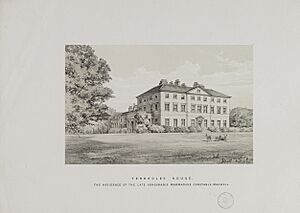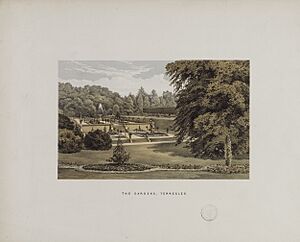Terregles House facts for kids
Terregles House was a large country home built in the late 1700s. It was located near the village of Terregles, about two miles west of Dumfries in Scotland. This grand house replaced an older, castle-like building called a tower house. The tower house was once the home of important families, first the Lords Herries and later the Earls of Nithsdale. However, the 5th Earl, William Maxwell, lost his titles in 1716, and the family's connection to the house changed.
History of Terregles House
In 1776, Winifred Maxwell, the granddaughter of the 5th Earl of Nithsdale, became the owner of the Terregles property. In 1788, she and her husband, William Haggerston Constable, decided to build a new house. They hired an architect from Yorkshire named Thomas Atkinson. Once the new house was finished, the old tower house was taken down. The new Terregles House became home to the Constable-Maxwell family and their seven children.
The house had its own Catholic chapel inside. This chapel also served the local Catholic community until a new church, St. Andrew's, opened in Dumfries in 1813.
Later, in 1831, another famous architect, Sir Robert Smirke, was hired. He added more parts to the house and built a new stable block.
In 1848, Winifred's grandson, William Constable-Maxwell, managed to get his family's old titles back. Ten years later, in 1858, he was officially declared the 10th Lord Herries of Terregles. His family, the Constable-Maxwells, continued to live at Terregles House until the early 1900s. After that, the property was rented out to other people.
After World War I, the lands around the house were sold. In the early 1930s, the house itself and everything inside it were also sold. During Second World War, Terregles House was one of several country homes in the area used by the Norwegian forces. It is known that King Haakon VII of Norway visited his troops in Scotland, but it's not confirmed if he visited Terregles House.
After the war, no one lived in the house again. In the 1950s, all its contents were removed. Sadly, the house had a serious problem with dry rot, a type of fungus that destroys wood. Because of this, Terregles House was blown up with explosives in 1962. The former stables, designed by Sir Robert Smirke in 1831, are still standing and are now a protected historic building.
Terregles Queir: A Family Crypt
The "Queir" (pronounced "choir") of Terregles Church was built by the Catholic Maxwell family in 1585. It served as their special burial place, or crypt, after the Reformation. In 1875, it was updated for Alfred Constable-Maxwell by an architect from Dumfries named James Barbour.
Even today, an annual special church service, called a Requiem Mass, is held here in June for the family. This service is organized by their descendants, the Maxwell-Stuart family from Traquair House. The Queir is connected to the parish church but is a separate part of it. At the top of the stairs leading down to the crypt, you can see a beautiful sculpture called "The Angel of the Resurrection" by John Birnie Philip.



